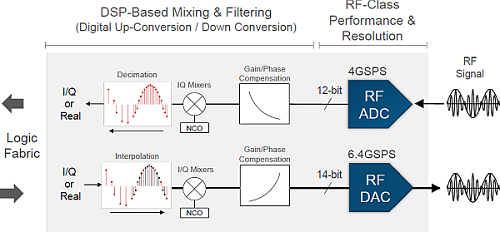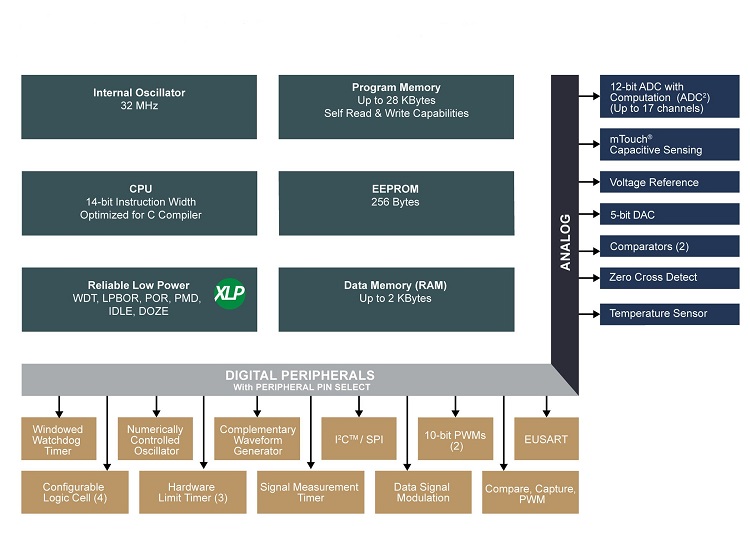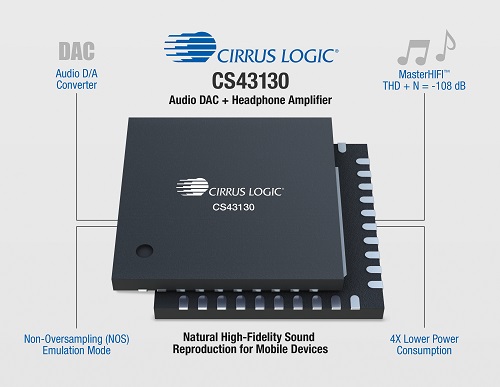By Majeed Ahmad, contributing editor
The exponential rise in data consumption and the growing use of mobile data and high-speed internet continue to drive the demand for analog-to-digital converters (ADCs) and digital-to-analog converters (DACs). According to Research and Markets, the demand for data converters will grow at a CAGR of 8.9% from 2017 to 2021.
Here are some key patterns for employing ADC and DAC devices into next-generation electronic designs.
1. RF innovation for 5G
The wireless industry is steadily moving from 4G to 5G infrastructure, and here, the need for wide input bandwidth, higher sampling rates, and greater spectral efficiency is driving innovation in the data converter realm. The 4G and 5G wireless networks encompass a large number of signal bands, and that makes data converters a crucial part of the overall RF signal chain.
For a start, a new breed of data converters now offers direct-to-RF signal synthesis, which simplifies radio design and lowers overall system cost. Take, for instance, the AD9208 analog-to-digital converter from Analog Devices Inc. (ADI), which features direct RF signal processing and thus eliminates mixer stages.
ADI is targeting its new ADCs built on the 28-nm process at multi-band wireless backhaul designs for 4G and 5G networks. AD9208 facilitates direct RF sampling of wideband signals beyond 6 GHz, which allows RF engineers to simplify the front-end filtering.

Fig. 1: The block diagram of ADI’s AD9208 analog-to-digital converter.
ADI has also made available a DAC for 4G and 5G multi-band wireless base stations. It offers direct-to-RF synthesis for up to 6 GHz, eliminating the need for IF-to-RF up-conversion stage and local oscillation (LO) generation. AD9172, built on the 28-nm process, can also serve defense electronics and instrumentation use cases involving gigahertz bandwidth applications.
2. FPGAs with data converters
Another design venue involving data converters and 5G base stations converges around FPGAs. The 5G base stations encompass an extensive use of multiple-input multiple-output (MIMO) radios, and here, FPGAs incorporating the ADC and DAC circuitry can reduce the design footprint and bill-of-materials (BOM) complexity.
These FPGAs can eliminate a wide array of off-chip data converters as well as analog front-end components like mixers commonly used in base station designs and can perform direct down-conversion from RF to digital. The integrated ADCs and DACs also reduce power consumption and remove the need to support off-chip JESD204 serial links between FPGAs and discrete data converters.

Fig. 2: A view of the RF subsystem with integrated ADC and DAC circuitry in Xilinx’s Zynq SoC device.
The current 4 x 4 and 8 x 8 MIMO radios are struggling with power consumption and board space, so FPGA suppliers like Xilinx are toying with the idea of deploying data converters as blocks. Moreover, Xilinx is building these devices around a FinFET process, which will further boost the energy-efficiency advantage compared to discrete data converters.
The FPGA developer is planning to run the 12-bit ADC at up to 4 Gsample/s and the 14-bit DAC at up to 6.4 Gsample/s in its new FPGA that will also include DSP blocks tuned for digital mixing and filtering. Engineers at Xilinx are confident that they can effectively manage the isolation between the analog and digital sections of the FPGA.
3. MCUs boast intelligent analog
If FPGAs are becoming a key enabler in 5G base station designs by integrating data converters, at the lower end of the design value chain, microcontrollers are doing the same to enable smaller and more energy-efficient IoT designs.
The humble 8-bit microcontrollers are incorporating analog-to-digital converters with computation (ADC2 ) to provide more accurate analog sensor readings and, ultimately, higher-quality end-user data. The integrated ADC also facilitates the faster conversion of analog signals, which, in turn, results in more deterministic system responses.
Microchip’s new family of microcontrollers, PIC16F18446, specially designed for sensor nodes, employs 12-bit ADC2 circuitry to carry out filtering autonomously. But more importantly, the ADC2 features the ability to wake the MCU core only when needed, which lowers power consumption and allows sensor nodes to run on small batteries.

Fig. 3: Microchip has streamlined its PIC16F18446 microcontrollers for enhanced analog functionality.
Next, microcontrollers like Microchip’s ATmega4809 are incorporating functions such as core independent peripheral (CIP) in hardware rather than software. That reduces the amount of code and lowers the bar on software work. The intelligent analog peripherals like CIPs can also execute command and control tasks in the microcontroller.
This lowers the risk of delayed response and facilitates a better end-user experience. The integration of ADCs, and, subsequently, technologies like CIP, also shows how intelligent analog features are allowing 8-bit microcontrollers to create more efficient IoT designs.
4. Studio-quality audio
Data converters are also playing a critical role in enabling the high-resolution audio content for ultra-high-quality music playback. They help filter the unwanted noise and provide immunity against high jitter. Secondly, they ensure low power consumption to maximize the battery life of music playback devices like headphones.
The CS43130 digital-to-analog converter from Cirrus Logic is a case in point. It consumes 23 milliwatts of power, which, according to the audio chipmaker, is four times less than other high-fidelity DACs available in the market. And it offers up to 32-bit resolution and 384-kHz sampling rate to deliver superior audio quality.

Fig. 4: The DAC chip features non-oversampling emulation mode to ensure natural sound for consumer devices.
Audio designers are using such data converters in an analog/digital filter array to deliver the highest-grade reproduction of digital audio sources — in other words, music or audio close enough to the originally recorded sound in the studio.
Summary
The above highlights show how the growth story in data converters mostly revolves around the IoT, 5G, and smartphone markets, though military and defense applications also mark a significant growth venue for data converters. Then there are telecom and data center segments that continue to drive the ADC and DAC demand.
Within the data converter technology realm, parameters such as accuracy, linearity, power efficiency, repeatability, and sampling rate decide the suitability for specific designs. A diverse array of data converters can address a matrix of possibilities.
Advertisement
Learn more about Electronic Products Magazine





